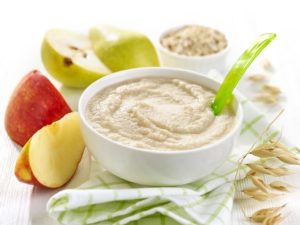Around the sixth month of life, it starts: the child no longer lives on milk alone. The first complementary food is required. What was taken for granted in earlier times, namely having to, being able to, and wanting to make baby food yourself, has shifted over the last few decades in favor of convenience food that is already prepackaged and ready to use. But in the wake of growing ecological awareness, young parents are once again increasingly preparing their own food, especially for babies.
When doing so, you should generally consider a few, but very important factors: Use only certified organic vegetables and cereals of the highest quality, for example from Demeter. The organic offer in the supermarket remains below this standard and does not guarantee the greatest possible freedom from harmful substances.
And: you should avoid seasonings. Salt, for example, is not metabolized at all by children’s kidneys until they are 18 months old. Internalize that your own adult taste has nothing to do with your child’s! If you follow these rules, making baby food yourself is easy and can be a lot of fun.
Table of contents
Make Baby Porridge Yourself: This Is How It’s Done!
Start with a single type of cooked vegetable, such as carrot, fennel, or kohlrabi. Add a small shot of high-quality oil, nothing else. This vegetable porridge is served in addition to the previous milk diet. To find out whether the baby tolerates the new food, first serve only one variety for a few days before introducing the next one.
As a next step, you can then mix the already familiar vegetables with a boiled potato and mash them. Do not forget the dash of oil!

If this is accepted and tolerated without problems, you can also add meat. Organic, of course, and preferably, because it contains the most iron, beef, or lamb. The Research Institute for Child Nutrition recommends 20 g of meat per day for six-month-old babies, as the baby’s iron reserves are used up after half a year.
And although the diet is slowly approaching what adults also find tasty, the rule still applies: avoid seasoning! Whole grain oat or millet flakes also contain iron and can be served as an alternative to or alternated with meat meals. For better iron utilization, you can feed a few spoonfuls of fruit porridge for dessert.
Cereal porridges given as the last step as an evening meal are somewhat challenging for the little organism, so it is recommended to use cereal flakes because they are easier to digest. Oatmeal is especially recommended here to start. Add fruit suitable for children, such as apple, first cooked, later it can also be raw, grated apple. Bananas are, of course, also a big hit in children’s diets, but can lead to constipation.
When making baby food yourself, let your child be your guide and “work with him.” Every child and every child’s digestion is different.
Even experts argue about whether cow’s milk can be used in children’s food in the first year. In any case, it should not be used in the first six months! As long as the child still gets breast milk or bottle milk meals, milk is unnecessary in the complimentary food anyway.
A tip among mothers is to boil the cereal porridge in water and – also because of the necessary fat – add a dash of cream. Here, too, the rule is to avoid seasoning. This also applies especially to the use of sugar! Sweeten with fruit.
Tips And Hints
- As you can see, making baby porridge yourself is not difficult. You will be able to experience and encourage your child’s awakening sense of taste quite differently and more intensively than if you simply unscrew a jar… dare!














6 thoughts on “Make Baby Porridge Yourself: This Is What You Should Consider!”